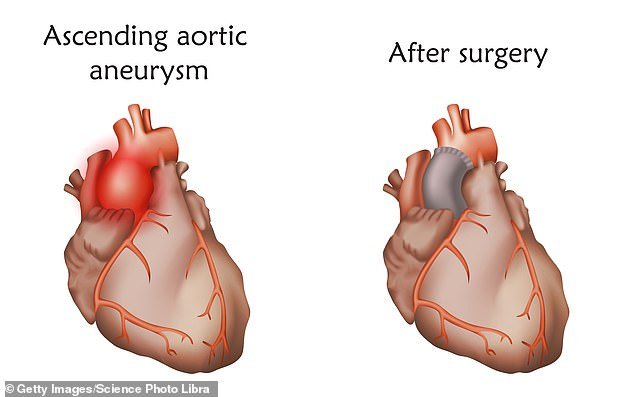ER doctor claims simple thumb test can tell if you’ll suffer a deadly ruptured artery… but is he right?
Emergency physician Dr. Joe Whittington sent the Internet into a frenzy this week when he shared a simple exercise that he said could be a sign you have a silent, dangerous heart condition.
In the test, which Yale cardiologists called the thumb-to-palm test, people place their hand flat on a table with their palm up or hold it out in front of them and reach their thumb across their palm.
If the thumb sticks out on the other side of the hand, Dr. Whittington said you have a 98 percent chance of having an aortic aneurysm — a dangerous bulge that could burst in the artery that carries blood from the heart.
The ER doctor claimed that the far reach of your thumb could be a sign that you have a collagen deficiency, which can lead to dangerous swelling in your blood vessels.
“Studies have shown that while not everyone with an aortic aneurysm has a positive test, those with a positive test have a 98 percent chance of having an aneurysm,” the California-based doctor said.
But as soon as it went viral, Dr.’s post disappeared. Whittington and it appears it has been removed from his TikTok accountleaving people wondering if what he shared was accurate.
How to perform the test: Hold your hand up as if telling someone to stop, or place your hand flat on a table, palm up (1). Keep your palm flat and extend your thumb over it as far as possible, towards your pinky finger. If your thumb reaches the center of the palm (2), this is normal. However, if it extends beyond the edge of your hand (3), researchers say it could be a sign of a collagen disorder, which could increase your chances of developing an aneurysm.

Dr. Whittington deleted his original video. In it, he said that people with a positive thumb-palm test “have a 98 percent chance of developing an aneurysm.”
However, before it was removed, people panicked.
A TikTok user shared a video of herself taking the test with her thumb hanging over the edge of her palm with the caption “Should I be worried?”
Another commented on the post: ‘Oh great. Now I need another support group for my TikTok anxiety.”
The science behind the test is complicated, said Dr. Muhammad Siyad Panhwar, an interventional cardiologist at Sanford Health.
“There is no need to panic,” he said in a TikTok in response to Dr. Whittington.
While it’s true that the palm-to-thumb test can be a sign that you have a collagen deficiency, it doesn’t confirm that you definitely have an aneurysm, Dr. Panhwar added.
Collagen is a stretchy, supportive fiber found throughout the body – and is especially important for helping blood vessels maintain their shape over time.
If you are deficient in collagen, you may have weaker blood vessels, which are at greater risk of expanding over time from stress, causing an aneurysm.
Certain collagen disorders have been linked to aneurysms of the ascending aorta, a region at particularly high risk because it is the main blood vessel arising from the heart, meaning it experiences a lot of wear and tear, says Dr. Kenan Yount, a cardiothoracic surgeon at the University of Virginia said in a video.
About eight to ten people with a ruptured aneurysm die before reaching the hospital. according to the NS. And aortic aneurysm ruptures caused about 9,904 deaths in 2019, according to the latest data from the CDC.
Dr. Yount highlighted conditions such as Marfan syndrome, Ehler-danlos syndrome and Loeys-Dietz syndrome.
These conditions affect your aorta, but also manifest in other parts of your body, such as your joints. People with collagen disorders often have hypermobile or extremely flexible joints.
The link between collagen disorders and blood vessel dysfunction is where the palm-to-thumb test comes into play.

If you have an ascending aortic aneurysm that grows so large that treatment is needed, doctors sometimes implant surgical mesh around the vessel to support it.
It was developed in 2021 after Yale cardiologists examined 305 patients already in the hospital for heart surgery.
Of those, 93 patients were there because of an ascending aortic aneurysm, meaning they had an aneurysm on top of the blood vessel that extends from the heart.
Ninety-eight percent of those 93 patients had a positive thumb-to-palm test, on which Dr. Whittington could base his claim.
“Our study showed that the majority of aneurysm patients do not show a positive thumb-palm sign, but that patients who do have a positive test have a high probability of having an aneurysm,” study author Dr. John Elefteriades, director emeritus of the Aortic Institute at Yale New Haven Hospital, said.
This means the test may be a sign to talk to your doctor about your risk of developing aneurysms, but it is not a diagnosis of an aneurysm, he said.
And even if you have a positive thumb-palm test and it turns out you also have an aneurysm, that’s no need to panic as not all aneurysms are emergencies, Dr. Panhwar said.
‘This is not an emergency. These aneurysms typically grow very slowly and we often monitor them every year with ultrasounds or CAT scans,” he said in his TikTok.
If your doctors determine that your blood vessel extends into dangerous territory, they will send you for a five-hour surgery to support that part of your blood vessel with a flexible sleeve, similar to a garden hose.
Recovery takes about four to six weeks.
If an aneurysm is left untreated, it can grow so large that the stress on the tissue causes the blood vessel to rupture or burst, said Dr. Yount, adding that “both of these scenarios could be life-threatening.”
Symptoms of a ruptured aorta include a tearing sensation in the chest, severe back pain, and dizziness.
The best way to use this test, Dr. Panhwar said, is to take advantage of the information it provides.
If you have a positive palm-to-thumb test and a family history of collagen disease, you should contact your doctor.
He added: ‘Don’t worry, you’re not going to die overnight from a burst aneurysm. Just go talk to your doctor, that’s all.’

